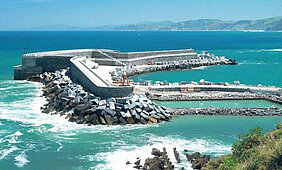In November of 2011, the world’s first commercially driven wave power plant project took up operations in the community of Mutriku (Northern Spain). It now serves as an example for other such projects of sustainable power generation. Built by the Spanish power supply company Ente Vasco de la Energía (EVE), and equipped with German technology, this wave power plant with its 16 Wells turbines is yielding a total power output of 300 kilowatts. This is enough to supply approximately 250 homes.
The wave power plant in Mutriku is utilizing the principle of the oscillating water column “OWC”). This means that every rising wave forces water into chimney-like concrete tubes, while each falling wave suctions the water back out. Turbines are installed at the upper end of the „chimneys”. The rising and falling of the water column, respectively, causes the compression or aspiration of the air in the concrete tubes, creating an airflow at the outlet that powers the turbines. The functionality of the turbines, which have been named after their inventor, British design engineer Allen Arthur Wells, is independent of the direction of flow. Unlike tidal power plants, wave power plants operate independently of ebb and flow, around the clock, and without consuming any resources.
The turbines do need to be protected from extremely rough seas, however. To this end, an electrically-powered butterfly damper is mounted at the outlet, between chimney and turbine. ts functionality resembles that of a smoke damper, meaning that the air flow reaching the turbine can be regulated, if needed. The turbine can also be completely sealed off. In order for this regulating mechanism to work, the damper position must be monitored and communicated to the governing control system. This task requires a sensor capable of handling the tough operating conditions: Salty, humid air, and the cyclical pressure oscillations must not interfere with its reliable functioning, because the safe operation of the turbine depends on it. The wave power plant utilizes magnetic rotary sensors of the RFC4800 series from Novotechnik to sense the real-time position of the dampers upstream from the turbines.
The sensors have already demonstrated their durability in another wave power plant, on the island of Islay, off the West Coast of Scotland. The Limpet plant was commissioned in 2000. To this day, it is still operating as a testing and research site. It has delivered mains power for a total of more than 70,000 hours – with the help of the reliable sensors that were used in its design.



